

 |
 |
| Inhabitants | Setup | Photography |
 | This is a yellow shore crab. These crabs are buried in the mud at low tide and are very easy to find. I released about ten of them at Alki since so many were hidden in the initial batch of substrate. They are pretty territorial and grow quickly. I put them in before chilling the tank and the room-temperature water made them extremely hyperactive. |
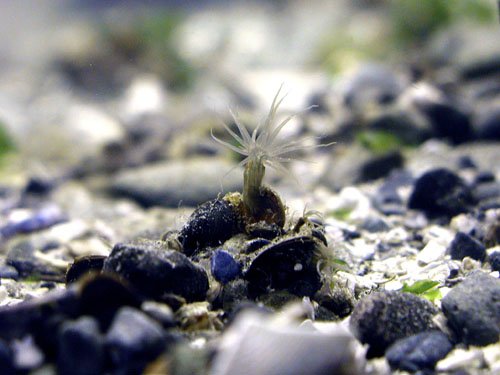 | A small anemone. During the first few weeks, these were appearing everywhere, as if from nowhere. It was a little creepy. I guess that must be how this sort of thing happens. |
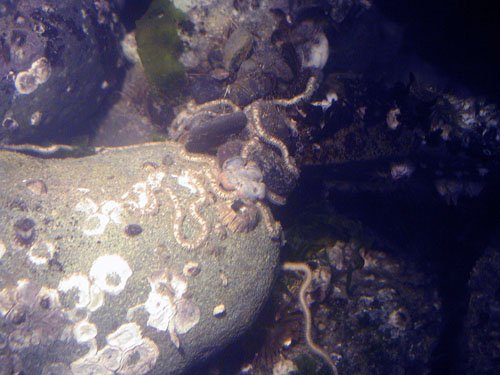 | We dug up 3 brittle stars like this while clamming/geoducking at Edmonds. They live in the substrate so I haven't seen them since they were added to the tank, except for the very tips of their arms coming out of the sand, on occasion. I have heard that they are good for the tank since they sift through the substrate and reduce the chances of anaerobic conditions forming, which can lead to the creation of toxic hydrogen sulfide. |
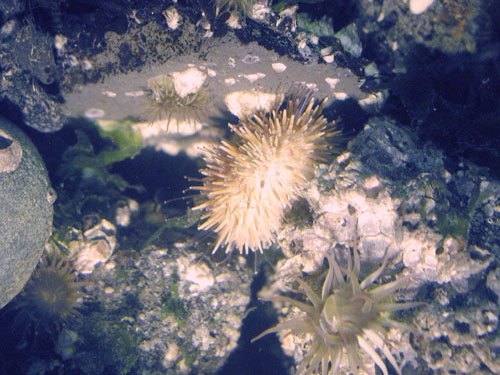 | I found this urchin at Edmonds at low tide. There is also a green one in the tank. Urchins can become tasty but expensive sushi. |
 | I think this is a Bering hermit crab but I haven't checked. I usually see hermits this size in fairly shallow water (< 20 fsw) |
 | A large red anemone. These are the ones that eat all my eelgrass. |
 | A large yellow anemone. |
 | Here is the tank on May 8, 2003, noticeably lacking plant life. That spot on the left side is a limpet. |
 | This is a northern feather duster worm, partially out of its tube. |
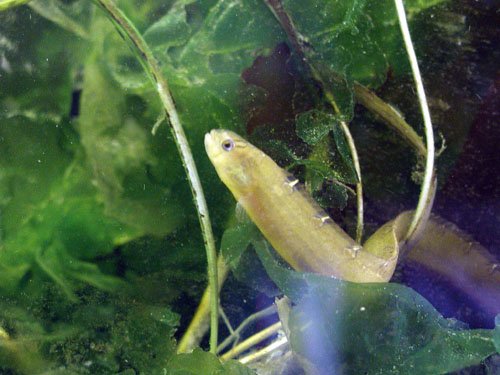 | Digging for clams will usually yield at least a few gunnels. This one and three others like it were dug up at Edmonds. They are pretty active hunters and I think they are responsible for eating a good number of the barnacles and amphipods that have disappeared. They also seem partial to frozen mysis shrimp. Gunnels seem to be very curious and when I'm poking around in the substrate they will come right up to my hand or my hagen multitool to see what's going on. Shown here is a crescent gunnel. |
 | This is a little white metridium. These are the ones that we commonly see covering every square inch of an underwater structure. I also heard that they can live some 200 years. This one is a baby compared to the giants in the Sound. |
 | A coonstripe shrimp. Puget Sound is infested with these creatures. They are also tasty when deep fried in batter. |
 | Here is the tank on 5-23-2003. The anomalous long orange-ish blob in front is an orange seapen I found lying on the beach during the extreme low tides after the lunar eclipse. They can change size and shape to a surprising degree. This one was about a third of its current length when I found it so I mistakenly thought it would be a good size for the tank. I have since taken it back in exchange for a much smaller one.
Despite its vegetable-like appearance, a seapen is actually a colony of cnidarians (related to starfish, etc.), and can dig and move around the tank on its own. A good number of orange seapens reside at Seahurst Park in Burien where they are devoured by swarms of striped nudibranchs. The plants were added on 5-17 and include eelgrass, bull kelp, sea lettuce, and some other stuff I haven't identified. The eelgrass came with a large number of amphipods (mostly the "skeleton shrimp" variety) which have since become tasty snacks for the gunnels and sculpins. If you look closely you can see a gunnel hanging off the eelgrass on the right side. |
 | This is Mr. Chiton, moving at top speed over a rock. I have to watch out to make sure the large chitons don't get on the front of the tank. Their little rasping tongues can leave scour marks in the acrylic, which I will later have to sand out. |
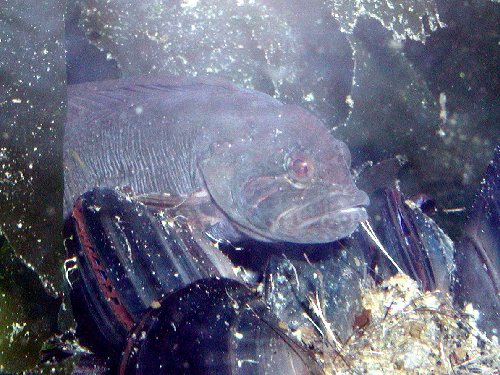 | This cockscomb was dug up from Edmonds along with the gunnels. It mostly stays near the bottom and can change colors to some degree. |
 | There are quite a few of these drab sculpins in the tank, since they are so plentiful near shore. They are rather hardy and aggressive at feeding time. |
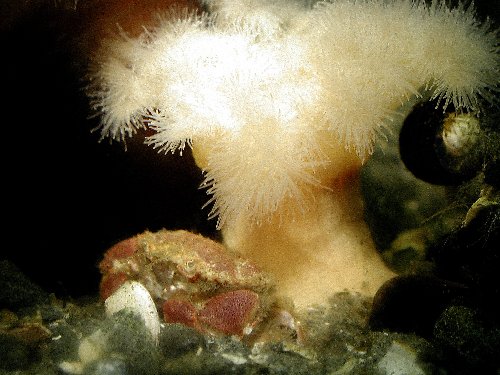 | I think this is a hairy cancer crab. There are two of these in the tank. This one has molted a couple of times since I got him. Once in a while I see him pinching off anemone tentacles. |
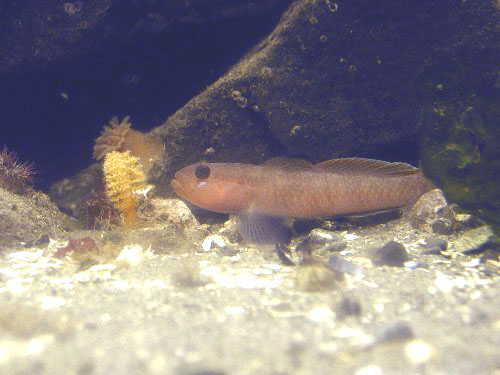 | Here is a black-eyed goby facing a baby seapen. The goby stays on the bottom pretty much all the time and sometimes hides in the little caves, especially if I shine a bright light at it. |
 | There are currently three sailfins sculpins in the tank (small, medium, and large). This is the medium one. The three like to hang out together and sit still most of the time (which makes them pretty easy to shoot). The largest sailfin came in with a load of parasites. Here's how I got rid of them. |
 | I could have sworn I had a picture of the speckled sand-dab in here... |
 | The grunt sculpin supposedly makes a grunting sound if you take it out of water or squeeze it or dance around it or something. But i've never heard it. Luckily, for my viewing pleasure, this one likes to stay out in the open and scoot around on his pectorals (you divers know what I'm talking about). |
 | Here is the tank on August 12, 2003, after a replanting and some new rocks. |
 | A closer look, from an angle. |
| Sign Guestbook | View Guestbook |